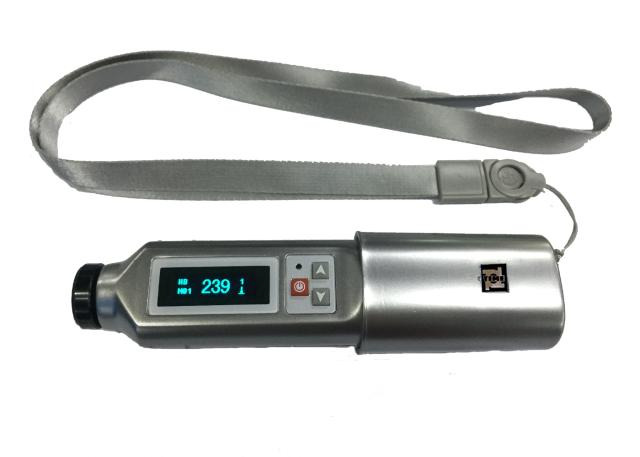TIME 510D Hardness Tester
The TIME 510D hardness tester works by using dynamic rebound testing according to the Leeb hardness testing method. With this method the hardness value is calculated from the energy loss of an impact body upon the surface of a material metallic materials. The device measures the speed in which an impact body bounces back from the tested surface. Harder surfaces provide faster rebounds.
Leeb hardness testing was invented in 1975 in Switzerland and has become one of the most popular portable testing methods currently available. Tests using this method can be performed per the ISO 16859 and ASTM A956 standards.
Results are calculated in the HL# scale and converted to Rockwell B & C, Vickers, Brinell, and Shore according to the instrument. The scale can vary based on the shape of, impact speed and distance between indentor ball and test object, these variations are shown in an extra indication behind HL. Such as HLC. HLD, HLD+15, HLDL, HLE, HLG and HLS. The TIME 510D uses an HLD tester and has a range of 170 to 960 HLD with an accuracy of 3 HLD. The test unit is integrated in the device.
With its OLED display, mobile phone app (Android) and the ability to print real time results directly through a (optional) Bluetooth wireless printer the TIME 510D is versatile and efficient in the field. Parameters and hardness conversion tables can be set through the phone app together with auto save. It also makes it possible to read the up to 100 groups data storage.
Time Leeb hardness testers are available since 1991 and can be seen as the current standard for portable hardness testers.
Features
- Hardness values in Rockwell HRB, HRC, Vickers HV, Brinell HB, Shore HS, Leeb HLD
- Measuring range e.g.:
- HLD 170 untill 960
- HRC 20 until 68;
- HV 81 until 955 - Conforms to ASTM and DIN norms
- Memory up to 100 data in group files
- High accuracy ≤0,5% at 800 HLD
- Tests at any angle, even upside down
Hardness testing of metallic surfaces.
Hardness testing can be divided in a two categories, Bench hardness testers and portable hardness testers.
Bench hardness testers usually determine the hardness of a sample using standard methods of Rockwell, Vickers, Brinell, or Shore, most commonly used is testing the resistance of the material to plastic deformation. In general bench hardness testers are large and heavy, are installed either on a table or a floor and weigh >50 kg. The advantage of these testers is that it is easy to control test environment and method of testing. Stationary equipment has a high rate of repeatability which a more accurate result.
Portable hardness testers are smaller in size and weigh making them easier to use in the field. Most of these testers are of the nondestructive type and use technology like rebound, electromagnetic or ultrasonic. Modern portable hardness testers can detect the hardness in basically all hardness scales. They are portable and in most cases easy to operate. No sample is required as the test can be performed directly on the component. Most modern portable hardness testers can are equipped with an internal storage to store the test data, and many use an app to set parameters and transfer data to a computer or server for reporting purposes.
| Material | HLD | HRB | HRC | HB | HV | HS |
|---|---|---|---|---|---|---|
| Steel & cast steel | 300 - 900 | 38.4 - 99.8 | 20 - 68.4 | 81 - 654 | 81.1 - 955 | 32.5 - 995 |
| Cold work tool steel | 300 - 840 | - | 20.4 - 67.1 | - | 80 - 898 | - |
| Stainless steel | 300 - 800 | 46.5 - 101.7 | 19.6 - 62.4 | 85 - 655 | 85 - 802 | - |
| Gray cast iron | 360 - 650 | - | - | 93 - 334 | - | - |
| Nodular cast iron | 400 - 660 | 23.8 - 34.6 | - | 131 - 387 | - | - |
| Cast aluminium | 200 - 570 | 13.5 - 95.3 | - | 26.8 - 164 | - | - |
| Brass | 200 - 550 | - | - | 40 - 173 | - | - |
| Bronze | 300 - 700 | - | - | 60 - 290 | - | - |
| Copper | 200 - 690 | - | - | 45 - 315 | - | - |
| Wrought steel | - | - | - | 143 - 650 | - | - |
Complete Kit
The TIME 510D will be delivered as complete set and includes:
- TIME 510D with integrated impact device
- HLD test block
- Support ring
- Cleaning brush
- Carrying case
- Charger
- Lanyard
- Instruction manual
- Manufacturer´s calibration certificate
- Warranty card
Specifications
| Standard impact device | D integrated |
| Hardness scales | HL(D), HRC, HRB, HRA, HV, HB & HS |
| Measuring range | 170 - 960HLD |
| Accuracy | 6HLD (±3HLD) |
| Min. surface roughness of workpiece | ≤1,6µm(Ra) |
| Max. workpiece hardness | 940HV |
| Min. workpiece thickness coupled | 5mm |
| Min. thickness of hardened layers | 0,8mm |
| Output | Bluetooth |
| Charging time | 2 hours |
| Continuous working time | 8 hours |
| Power | Rechargeable battery |
| Operating temperature | 0°C to 40°C |
| Overall dimensions | 145mm×35mm×30mm |
| Weight | 130gr |
Buy Now
Availability: Available: 1 - 3 days, Delivery time: 1 - 3 weeks, special order request









